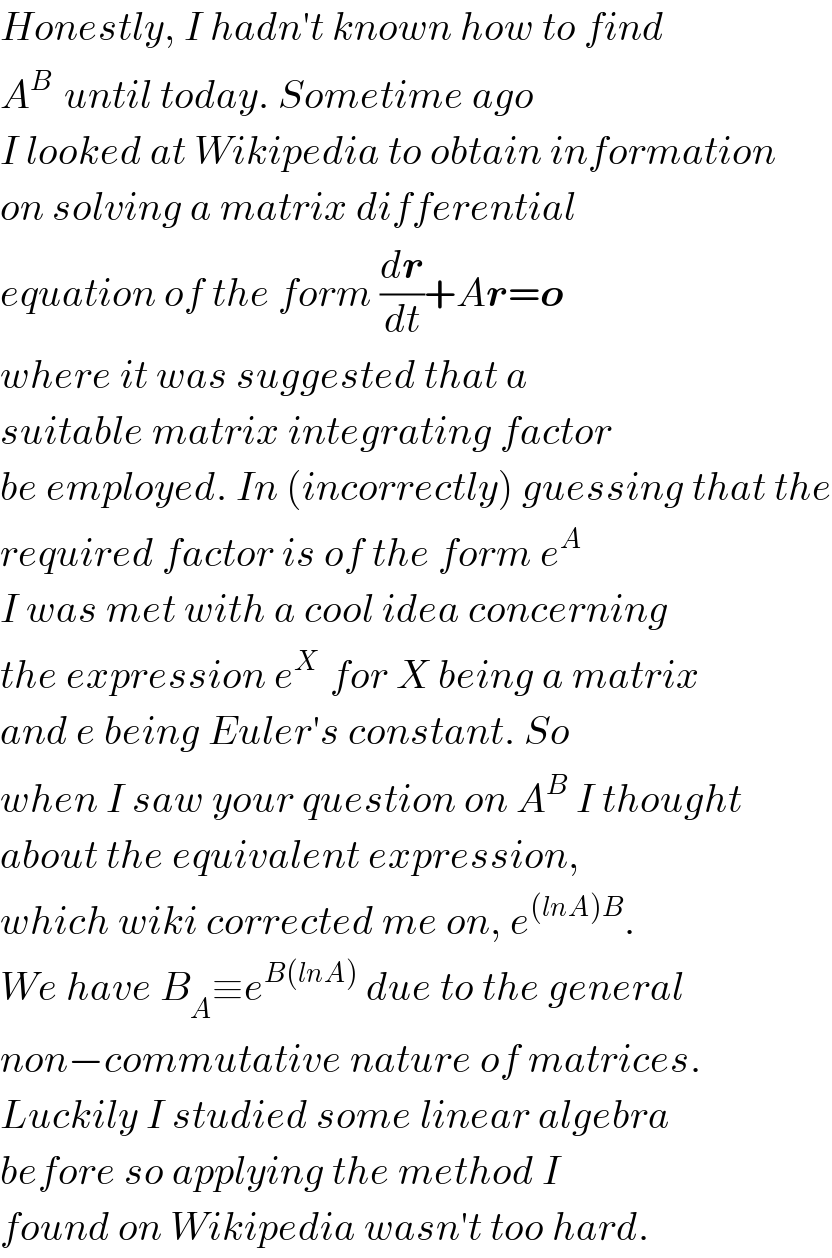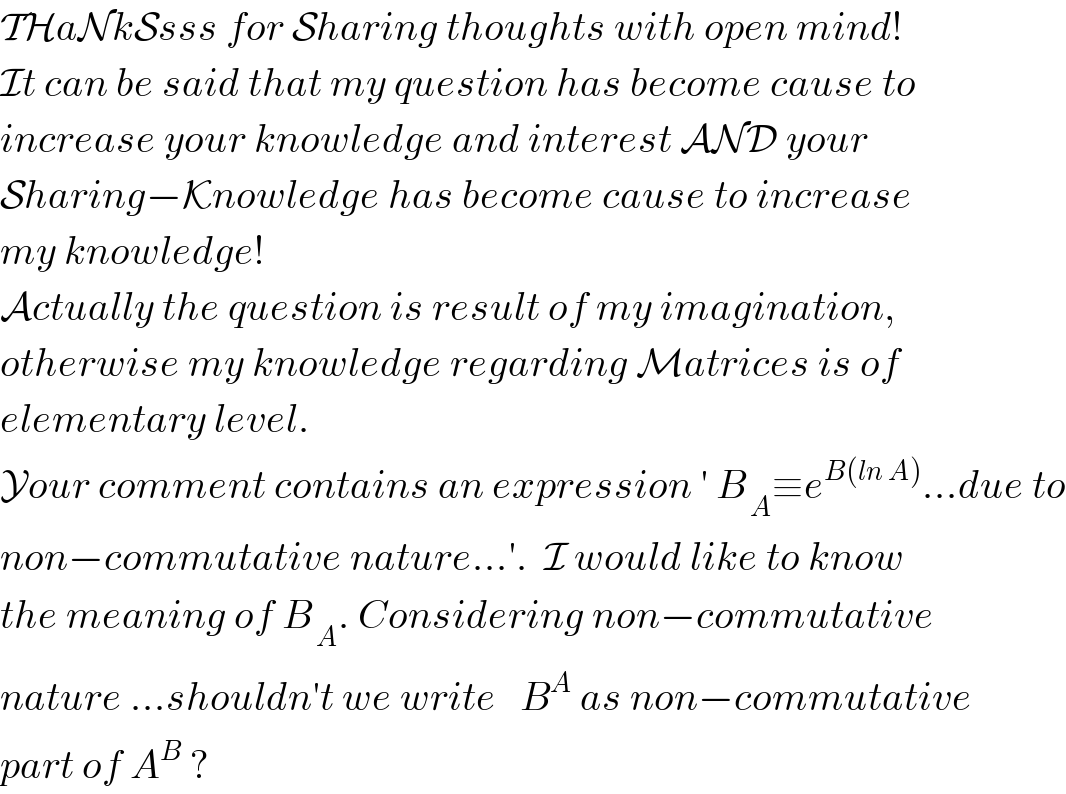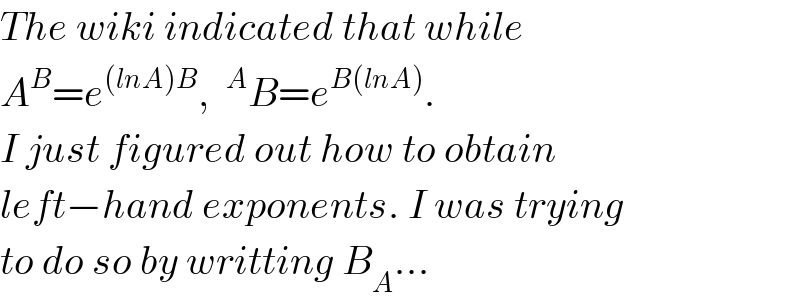
Question and Answers Forum
Previous in Matrices and Determinants Next in Matrices and Determinants
Question Number 2564 by Rasheed Soomro last updated on 22/Nov/15
![A= [(1,2),(2,5) ],B= [(3,(−1)),(4,(+2)) ] determine A^B](Q2564.png)
Answered by Yozzi last updated on 22/Nov/15
![∣A∣=5−4=1≠0 ⇒A is non−singular. A^B =e^((lnA)B) =Σ_(k=0) ^∞ (1/(k!)){(lnA)B}^k For eigenvalues k of A ∣A−kI∣=0 ∴ determinant (((1−k 2)),((2 5−k)))=0 (1−k)(5−k)−4=0 5−6k+k^2 −4=0 k^2 −6k+1=0 (k−3)^2 −9+1=0 (k−3)^2 =8⇒k=3±2(√2) For k=3+2(√2), (∵ Ae=ke⇒(A−kI)e=0) [((1−3−2(√2) 2)),((2 5−3−2(√2))) ] [(x),(y) ]= [(0),(0) ] (−2−2(√2))x+2y=0⇒y=(1+(√2))x.....(i) 2x+(2−2(√2))y=0 x+(1−(√2))y=0......(ii) y from (i) leads to x+(1−(√2))(1+(√2))x=0 x+(1−2)x=0 x−x=0 (true) ∴ We can choose eigenvector e_1 = [(1),((1+(√2))) ] for k=3+2(√2) For k=3−2(√2) [((−2+2(√2) 2)),((2 2+2(√2))) ] [(x),(y) ]= [(0),(0) ] ⇒(−1+(√2))x+y=0⇒y=(1−(√2))x ..............(iii) and 2x+(2+2(√2))y=0⇒x+(1+(√2))y=0........(iv) y from (iii) into (iv) gives x+(1−2)x=0⇒x−x=0 (true) So let e_2 = [(1),((1−(√2))) ] for k=3−2(√2). ∴ Let V=[e_1 e_2 ]= [((1 1)),((1+(√2) 1−(√2))) ] and A^′ = [((3+2(√2) 0)),((0 3−2(√2))) ]⇒lnA^′ = [((ln(3+2(√2)) 0)),((0 ln(3−2(√2)))) ] V^(−1) =(1/(∣V∣))adj(V) adj(V)= [((1−(√2) −1)),((−1−(√2) 1)) ] ∣V∣=1−(√2)−1−(√2)=−2(√2) V^(−1) =((−1)/(2(√2))) [((1−(√2) −1)),((−1−(√2) 1)) ] ∴ lnA=V(lnA^′ )V^(−1) lnA=((−1)/(2(√2))) [((1 1)),((1+(√2) 1−(√2))) ] [((ln(3+2(√2)) 0)),((0 ln(3−2(√2)))) ] [((1−(√2) −1)),((−1−(√2) 1)) ] lnA=((−1)/(2(√2))) [((ln(3+2(√2)) ln(3−2(√2)))),(((1+(√2))ln(3+2(√2)) (1−(√2))ln(3−2(√2)))) ] [((1−(√2) −1)),((−1−(√2) 1)) ] lnA=((−1)/(2(√2))) [(((1−(√2))ln(3+2(√2))−(1+(√2))ln(3−2(√2)) ln(((3−2(√2))/(3+2(√2)))) )),(( ln(((3−2(√2))/(3+2(√2)))) (1−(√2))ln(3−2(√2))−(1+(√2))ln(3+2(√2)))) ] ∴(lnA)B=((−1)/(2(√2))) [(((1−(√2))ln(3+2(√2))−(1+(√2))ln(3−2(√2)) ln(((3−2(√2))/(3+2(√2)))))),(( ln(((3−2(√2))/(3+2(√2)))) (1−(√2))ln(3−2(√2))−(1+(√2))ln(3+2(√2)))) ]×B](Q2572.png)
Commented by RasheedAhmad last updated on 22/Nov/15

Commented by Yozzi last updated on 22/Nov/15

Commented by Rasheed Soomro last updated on 23/Nov/15

Commented by Yozzi last updated on 23/Nov/15

Commented by Rasheed Soomro last updated on 23/Nov/15

